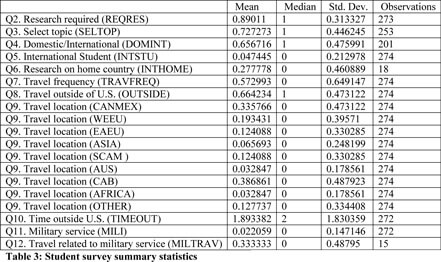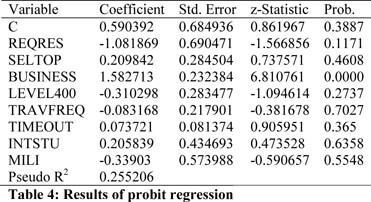Different Views of the World: What Do Students Choose to Study When Given the Opportunity?
Published in:
November 16–17, 2012
Dillard University and Xavier University of Louisiana
New Orleans, Louisiana
In any particular class, students rarely have the opportunity to select the topics that they study. So, when given the choice, such as on a semester long research project, what do students choose, something simple and close to home, or a topic that will require a more global perspective? This question is addressed using survey data from a range of social science and business classes.
College students are exposed to a wide range of concepts and ideas as they pass from their first year to the final year of their programs. Selecting a major such as business, engineering, or communications sets the student on a prescribed pathway towards completion in which they will be required to take a number of specific courses designed to give them the skills that they will need to work and practice in their chosen professions. Students are also required to take a range of liberal arts and science courses intended to round out their academic experience. Along this path, it is also important that students gain some understanding of the world community in which they will eventually live and work.
In this study, I examine students’ exposure and interest in the global community through two channels, their backgrounds and their choices. While utility theory would suggest that students’ past travel or background reflects their choices, that view would only apply if the individual student fully planned their own travel. Given that in general, college students range in age from 17 to 22, the amount of travel that they have actually planned themselves is likely to be limited. Still, past travel experience may impact students’ choices. Another important factor, though, is whether students have a choice in what they choose to focus on in a particular class. If an instructor has preselected a topic or area to study, then the student has little choice.
Over the past decade, the question of students’ global perspective and viewpoint has taken on greater importance. Speter (2011) reports that over fifty percent of the nation’s college students have some concern about globalization and globalized economic activity. Speter’s primary concern is that college students represent the future leaders of the nation. Thus how they view themselves, the country, and world in terms of globalization is an important indicator of the direction the country will move in the future.
Janavaras, Kuzma, and Thiewes (2008) surveyed students from business and the liberal arts to evaluate potential differences in views on globalization. Their study found that business students had a more positive view of globalization than liberal arts students. Following up on this study, Akcam, Guler, and Hakim (2012) evaluated factors that may account for business students’ more positive views on globalization. They concluded that business students generally were more accepting of the following ideas: organizations received the greatest benefit from globalization; and students will need to compete on a global level and develop the requisite skill sets for doing so.
How interested are students in the wider world, and how does their background affect their choices in what they study? This is the underlying question that is assessed in this study. To address this question, a range of students in social science and business courses were surveyed. Section 2 provides an overview of the survey and the classes surveyed. The results of the survey are reported in Section 3. Section 4 is a probit analysis to evaluate how student backgrounds and exposure to globalization affect their work choices. The conclusions of the study are presented in Section 5.
2. Survey and Population
Surveys were sent out to faculty members in the Departments of Business, Economics, Politics, Criminal Justice, History, and Technology Studies. No specific classes in particular were targeted, but the department chairs and administrative personnel that distributed the surveys to their faculty were asked to get them to instructors that were requiring students to complete independent research projects as part of their courses. Surveys were conducted during the latter third of the spring semester. With the exception of the course name and number, all survey responses from both instructors and students are anonymous.
The instructor survey asked the faculty member four questions:
- the course name and number;
- whether students were required to complete independent research for the course;
- if yes, could students select their own topics?
- how many students selected international topics?
The first four questions of the twelve question student survey asked essentially the same questions as the instructor survey. Students were asked an additional eight questions regarding their past travel experiences (Table 1).

3. Survey results
Survey results for fourteen courses are presented below. The courses reported include three economics courses, three criminal justice courses, six business courses, a politics course, and a technology studies course. Survey results are recorded as a dichotomous variable (0, 1) where “1” represents “yes”, and “0” represents a negative response. The results from the instructor surveys are shown in Table 2. Instructor results indicate that the majority of courses surveyed did require students to conduct independent research (Q2). Additionally they indicate that in general, students were able to select their own topics (Q3).

Summary student survey results are reported in Table 3. For questions 2, 3, 5, 6, 8, 11, and 12, all student responses are recorded as a dichotomous variable (0, 1) where “1” represents “yes” and “0” represents “no”. For question 4, “domestic” was recorded as “0” and “international” was recorded as “1”. For question 7, responses were recorded from “0” to “2” (0 represents infrequent; 1, occasional; 2, frequent). Responses for question 9 are recorded as a dichotomous variable with “1” representing that a student had visited a particular region, and “0” that a student had not visited that region. Question number 10 was recorded on a scale from “0” to “6” (0 represents 3 days or less; 1, 1 week; 2, 3 weeks; 3, 1 month; 4, 1 to 3 months; 5, 3 to 6 months; and 6, over 6 months).

Summary data indicates that 89 percent of the students reported that some type of independent research was required in the courses surveyed, and that for most of these courses, students were allowed to select their own research topic (72 percent). Almost two-thirds of the students that were required to conduct independent research completed that research on an international topic. Out of 274 students surveyed, just under 5 percent were international students.
The median of “0” for question 7 indicates that 50 percent of the surveyed students had traveled no more than 4 times outside of the Northeastern United States. Approximately 67 percent of the students had spent at least 1 week outside of the U.S. The top travel destinations in order were Canada/Mexico, the Caribbean, and Western Europe. These locations are followed by Eastern Europe, South and Central America, and Other, each with just over 12 percent. The median time spent outside of the U.S. was between 2 and 3 weeks. Only 2 percent of the students reported serving in the military and 33 percent of those students reported that their international travel was related to their military service.
4. Probit Analysis of the Survey Results
Are there identifiable factors that may predict or explain the particular topic that a student chooses to conduct their research on? This question is addressed using a binary choice probit model. The hypothesis in this case is that the topic a student completes their research on (DOMINT) is a function of whether the instructor allowed them to select their own topic (SELTOP), and their exposure to international experience (INTSTU, INTHOME, TRAVFREQ, OUTSIDE, TIMEOUT, and MILI). The results of the probit regression are presented in Table 4.

The probit analysis does not definitively identify any particular factors from a student’s personal experience that can account for whether a student selected an international topic or not. Included in the analysis are two dummy variables to ascertain differences across business and social science disciplines. The variable “BUSINESS” is a dichotomous variable taking on the value of “1” if the course is a business course and “0” otherwise. This coefficient is found to be positive and significant, indicative that business students are more likely to undertake research on international topics than other students are. The variable “LEVEL400” is also a dichotomous dummy variable taking on the value of “1” if the course is a 400 level course and “0” otherwise. In this case the estimated coefficient is not found to be significant. The coefficient on “REQRES,” whether research was required for a particular course was found to be significant in several different regressions at the 10 percent level; however, in the regression that is reported it is just outside of this level of significance.
5. Conclusions
The analysis does not readily identify travel experience factors leading students towards conducting research on international issues. It does though find that overall, business students are more likely to conduct research on international issues than students in the other disciplines that were surveyed. This result is consistent with other studies such as Janavara, Kumza, and Thiewes (2008) and Speter (2011), which find that business students appear to have a more positive outlook on international issues than other students.
As a whole, the survey results suggest that Farmingdale students have limited travel experience. While 67 percent of the students have spent at least one week outside of the U.S., it should be noted that the top two destinations were either in North America (Canada or Mexico) or the Caribbean.
This work is still preliminary. The analysis though suggests that more study is needed in this area utilizing a more detailed survey instrument that focuses greater attention to a wider range of academic, demographic and socio-economic factors.
References
Akcam, B., Guler, A., & Hekim, H. (2012). Freshman and Sophomore Business Students’ Perception of Global Forces. International Journal of Academic Research in Business and Social Sciences, 2(1), 364-383.
Janavara, B., Kuzma, J., &Thiewes, H. (2008). College of Business Majors’ Perceptions Toward Globalization: An Empirical Study. Journal of College Teaching and Learning, 5(3), 41-50.
Speter, K.M. (2011). Globalization: The Changing Views of American College Students (2007-2010). The International Business and Economics Research Journal, 10(6), 53-55.
Spring 2013: New Faces, New Expectations
